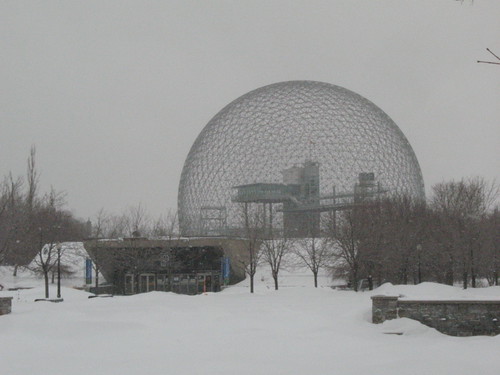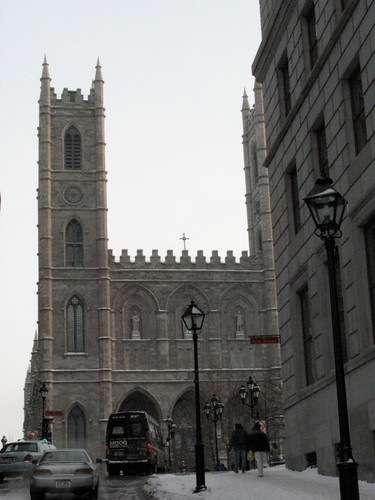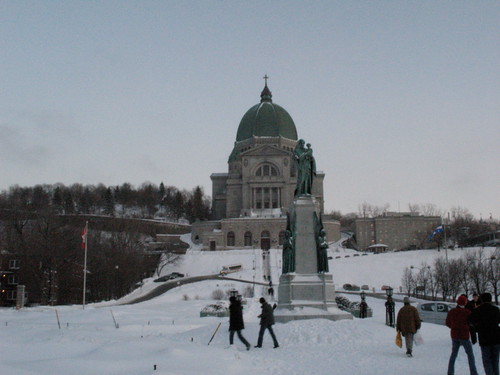I just finished reading Jules Verne’s 1886 novel Robur-le-Conquérant. Quite an enjoyable little book, though not really Verne’s best. I did appreciate all his exploration of the science behind the Albatross, Robur’s wondrous flying craft—Verne’s work is meant to educate as well as entertain, and I’m a sucker for a good science history lesson.
I just finished reading Jules Verne’s 1886 novel Robur-le-Conquérant. Quite an enjoyable little book, though not really Verne’s best. I did appreciate all his exploration of the science behind the Albatross, Robur’s wondrous flying craft—Verne’s work is meant to educate as well as entertain, and I’m a sucker for a good science history lesson. And I’m no engineer, so I can’t say how far-fetched it really is, with the seventy-four counter-rotating propellors to provide lift and the two large propellors at fore and aft for horizontal movement, but it’s clear Verne’s done his homework: he spends a couple of pages describing in great detail past research into heavier-than-air flight. There wasn’t any practical success by 1886 (and wouldn’t be for quite a few years), though certainly not for lack of trying.
I won’t nitpick the Albatross’ fantastically sturdy materials, nigh-indestructible parts and impossibly efficient batteries; that’s just hand-waved away by reason of Robur being a brilliant engineer. Which is okay: this was a time when scientific knowledge and engineering moxie were basically super-powers in their own right. Likewise, I’ll just sigh and try to ignore Verne’s chauvinism and racism: non-Europeans are almost all depicted as savage brutes or, at best, ignorant bumpkins: Prudent’s Black servant, Frycollins, is a stereotypical Coon character, contributing nothing to the story except a bit of tiresome comic relief. Again, sign of the times. I guess that stuff was funnier a hundred years ago.
The plot is nothing to write home about, and has a few gaping holes. We never find out what makes Robur (you know, the title character) tick, or why on Earth he’d kidnap Prudent and Evans—revenge? pride? to increase the numbers on his island hideaway?—and take them on a trip around the world. But whatever the reason we’re glad he did, because we the readers get to go along for the ride.
And what a ride it is. Here we have a flying machine that can go up to 200 km/h, more than twice as fast as the fastest trains of the day and, as Verne notes, fast enough to go around the world in just eight days, cross oceans and wilderness with the greatest of ease, and carry a small crew in perfect comfort. It’s hard to imagine now just how mind-blowing that must have been: back then there were no flying machines except balloons, which weren’t much good for long-distance transportation. Trains were pretty fast but not always terribly safe, and of course were limited by rails.
I think this is what science-fiction is all about: to see how technology and science can make possible whole new kinds of stories. Forget the plot: stories like this helped make the world a lot smaller to Victorian readers. And it’s hard to imagine just how big the world was back then. In those days it would have taken me days instead of hours to travel from, let’s say, Vancouver to Ottawa, and that’s if I could afford a train ticket. To communicate with my family in Ottawa I could have sent a telegram, or used one of those newfangled telephone machines—assuming the infrastructure reached to the West Coast, which is doubtful. If I was curious about some faraway place, I could go to the library or bookstore (or, if I were rich enough, my own books). If I were really lucky, there’d be photographs. Nowadays I have at my fingertips a vast information network undreamed of by even the most delirious futurologists of the 19th century. I can easily look up any information on the places the Albatross visits and follow its path on Google Earth™.
The journey begins in Philadelphia. On to Quebec City (which Verne calls «la capitale du Canada»—though that was only true for a few years), then Montreal with the Victoria Bridge, and Ottawa with its Parliament. Next is Niagara Falls, then Chicago and Omaha, Nebraska—just a few decades old then, and rightly called “The Gateway to the West,” being the point of origin of the developing railway system linking the eastern States with California.
We see Yellowstone Park, whose mountains, lakes, wildlife and famous geysers Verne describes in loving detail—despite never having seen them. He also notes (remember, educate as well as entertain!) that it was the first U.S. national park. On to Salt Lake City with the brand-new Mormon Tabernacle. We then cut straight across Nevada and northern California into the Pacific.
At this point Robur takes us straight north to Alaska (with a bit of gruesome and gratuitous whale-hunting in the North Pacific), across to Kamchatka in far eastern Siberia, south to Tokyo—formerly called “Edo”—followed by a quick hop over Korea and the Yellow Sea to Beijing. Then, southwest over the Himalayas, passing by Srinagar before heading west into «Caboulistan»—probably referring to Afghanistan, whose capital is Kabul. Herat (now an Afghan province, but then an independent kingdom) is also mentioned. Verne calls it «la clef de l’Asie centrale,» and alludes to the struggles between Great Britain and Russia for control of the region. I thought it was an interesting look at long-ago politics, until I remembered that region is still being fought over. The USSR invaded in 1979, then the US in 2001. Plus ça change…
Tehran comes and goes, followed by a jaunt north across the length of the Caspian Sea, passing by Astrakhan, then north to Moscow and St-Petersburg. We cut straight across the Baltic Sea and Scandinavia in a line joining Stockholm and Oslo (then called “Christiania” after its founder King Christian IV). South to Paris, further south to Provence, Rome and Naples, and then we leave Europe.
Tunisia (a French protectorate at the time) is the first stop on the North African coast. We travel west to Philippeville (founded in 1838 and probably named after the reigning French monarch of the time, Louis-Philippe; it’s now called “Skikda” since Algeria gained its independence in 1962). Algiers follows, then Oran.
Southeast into the Sahara, with notable milestones the towns of Laghouat and Ouargla, and south to Timbuktu. The novel mentions «le Soudan;» this doesn’t refer to present-day Sudan, but to a French colony which formed present-day Mali in 1960. Our exploration of the African continent ends in Dahomey where Robur and his crew kill a lot of evil Africans. That part reminded me of the scene in Verne’s earlier novel Five Weeks in a Balloon, where Dr. Fergusson’s team witness a battle between two cannibal tribes. One of the explorers, revolted by the goriness of the fight and the gratuitous snacking on still-warm flesh, shoots one of the cannibals dead before the balloon flies out of range. Both of these scenes, in two novels a quarter-century apart, similarly exaggerate the evilness of “Darkest Africa” and implicitly assert the rights of Westerners to swoop in (literally, in both cases) and act as judge, jury and executioner to people or kingdoms they don’t like. Plus ça change…
After leaving Africa, the Albatross heads straight to Tierra del Fuego, passing between the islands of St-Helena (where Napoleon I died in exile) and Ascension; it flies along the Strait of Magellan to Puerto Hambre (French: «Port-Famine») in Chile, then briefly turns south towards Antarctica, which was then mostly unexplored. Verne repeats various hypotheses about what’s really at the South Pole: is it a continent, an archipelago, or a sea of ice like the Arctic? Nobody knew, back then. Since it’s July and therefore winter in the southern hemisphere, the Albatross turns back up the coast of Chile until the Chonos Archipelago. They are then driven south again by a hurricane, pass over the south magnetic pole near the 78th parallel, almost get killed by an erupting Mount Erebus, but eventually regain control and end up in the Chatham Islands where the kidnappees manage to blow up the airship. And then they go home, assuming Robur to be dead.
There. Wasn’t that fun? Personally, I had a hell of a time looking up all these interesting factoids—and finding out Verne may have been wrong or out of date in a couple of spots: Ottawa, not Quebec City, was Canada’s capital in 1886—but maybe Verne was being patriotic, since Québec is French and Ottawa isn’t. Edo was renamed Tokyo in 1868—but maybe he used its old name to heighten the drama. I do suspect he made up the location of the south magnetic pole. As far as I know it was never measured directly in his lifetime, though the north magnetic pole was pinpointed in 1831 (around 70º N 97º W). Then again, I don’t know what theories were floating about regarding Earth’s poles and their movement. And to be fair, most of his other facts, calculations and trivia are very precise and up to date. Even if Verne didn’t add to the store of human knowledge, at least he fed the fires of imagination in many hearts and minds. Though I take the internet and rapid travel for granted, and have flown back and forth across Canada many times, there’s still so much of the world I haven’t seen.
Robur may have given me a few ideas.



